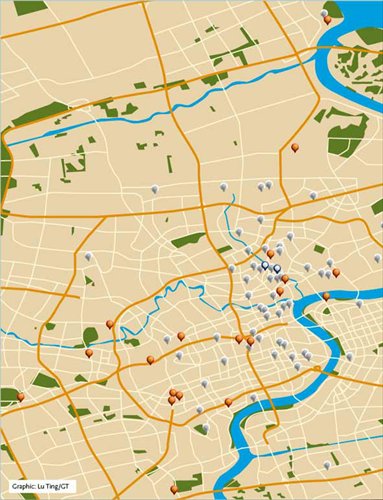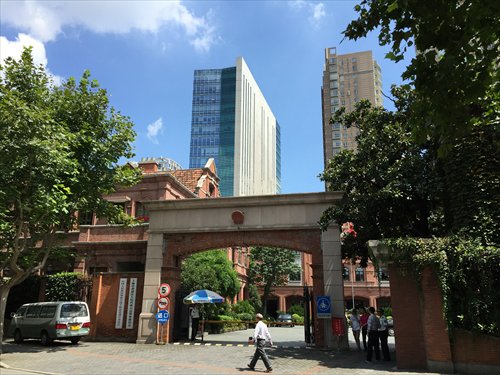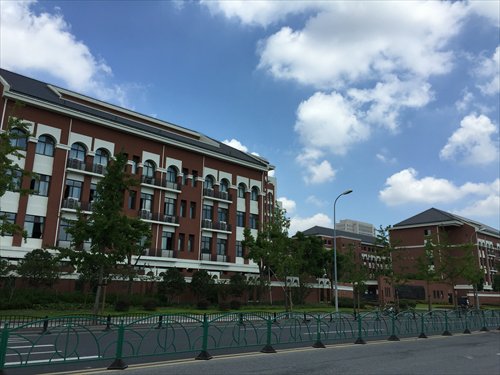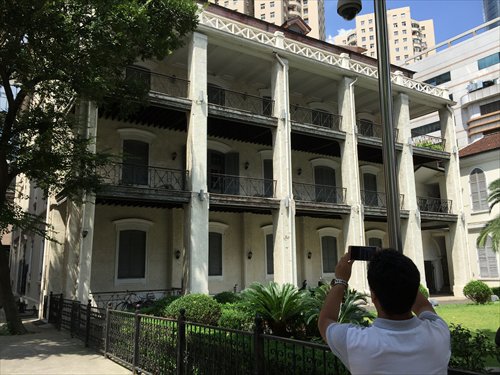HOME >> METRO SHANGHAI
War secrets unveiled
Source:Global Times Published: 2015-9-7 18:53:01
Map shows the locations of Japanese internment camps in Shanghai

The sites of former internment centers and prisoner-of-war camps in Shanghai Graphic: Lu Ting/GT
As China marks the 70th anniversary of the victory of World War II, historians have identified the locations of 20 internment and prisoner-of-war (POW) camps set up by Japanese troops in Shanghai during the war. These have now been featured on a map, which was published on August 31 by researchers at Shanghai Normal University.
The largest of these camps was the Longhua (Lunghua) Civil Assembly Center, which is now the Shanghai High School at Baise Road in Xuhui district. It housed 1,756 foreigners between 1943 and 1945 - 1,584 Britons, 39 Belgians, 37 Americans, 32 Australians, 24 Canadians, 17 Dutchmen, 11 New Zealanders, seven South Africans, three Russians, one Portuguese and one Norwegian. The detainees' ages varied from six months to 88 years.
"Few of the students at Shanghai High School would know that their school was once the largest detention camp in the city," said Su Zhiliang, a history professor at Shanghai Normal University. Though internment camps were not concentration camps like Auschwitz and had no gas chambers, they were often cruel and barbaric places, with Japanese authorities carrying out forced labor, starvation, savage beatings and executions.

The site of former an internment center Photo: Yang Hui/GT
Numbered armbands
Foreigners experienced the hardships of war just like the locals. Each detainee was only allowed to take four parcels of personal belongings into the camps. They had to wear armbands showing their nationality and an identifying number.
Every few months prisoners were allowed to write a short letter which was limited to 25 words and was restricted to a formulaic structure. Internees were not allowed radios and were forbidden to take photographs. They were given menial laboring work and their food rations were minimal and of poor quality.
Sometimes their rations were reduced to two small meals a day which occurred as punishment if internees tried to escape, for example.
Most of the major buildings of the former Longhua internment camp are preserved and many former prisoners have visited the site over the years.
When the Japanese army occupied Shanghai during World War II it established 20 camps to detain Chinese and war prisoners, along with the foreign residents from over 10 countries who had previously been living within the Shanghai International Settlement. There were eight internment camps holding more than 6,000 foreign nationals, six religious internment centers where clergy were detained and six POW camps which held combatants from China and abroad.
The first camp established was the Xuhui POW Camp, which was created in 1938 to hold Chinese soldiers and officials. During 1944 and 1945, more than 200 prisoners were held there - most of them came from the Kuomintang with some others from the Eighth Route Army and the New Fourth Army. The POW camp was surrounded by barbed wire with armed sentries patrolling it constantly. Anyone inmate caught trying to escape would be tortured and killed.
The Tilanqiao Prison POW Camp was a six-story concrete building on then Ward Road. The camp was surrounded by a five-meter wall with watchtowers. Four large gates took visitors into the camp and each gate was guarded by machine gunners. The inmates here suffered especially during the winter when their blankets could not keep the bitter cold at bay.
The Naval POW Camp on Jiangwan Road in Hongkou district had been a Japanese marine infirmary and most of the inmates here were British and American navy personnel. The ground floor housed ratings and Chinese prisoners and the second floor was used for officers.
The Jiangwan POW Camp was located at Yin'gao Road in Baoshan district and the site is now home to the Shanghai Gaojing Compulsory Detoxification Center. The Wusong POW camp, once a Japanese barracks in Baoshan, is now part of the Naval Museum.
The Daqiao POW Camp had been the Japanese Military Police Headquarters. The site is now home to the Daqiao building at Sichuan Road North in Hongkou district. The detainees here were mainly American civilians from Shanghai, American pilots and recaptured sailors and marines, as well as a few Chinese and British women.
There were 10 cells here and each measured 5.5 meters by 1.7 meters by 3.6 meters but more than 40 prisoners were crowded into these cells which could accommodate 25 seated people at the most.
Men and women were detained together and had to share the makeshift toilet. Lice, mosquitoes and mice thrived even if the prisoners didn't. They survived on scraps of tainted rice which was served twice a day.
Medical treatments were inadequate. One Japanese nurse visited the camp alongside two junior officers but they did not take symptoms seriously, only offering Asprin or a red liquid that looked like mercurochrome for boils. Many prisoners died under this regime.
During the day prisoners had to sit cross-legged with the heads bowed facing Tokyo for hours at a time. Sometimes guards would make them kneel for hours or they would be woken in the middle of the night for exercise. Anyone who complained or refused this would be beaten.

The site of former an internment center Photo: Yang Hui/GT
Former barracks
Foreigners who weren't classified as combatants endured hardships of their own in the city's internment camps. The Ash Camp at Great Western Road (now Yan'an Road West) opened in March 1943 and had formerly been a British army barracks, It was named because of the vast amounts of ash used to backfill its ground space to prevent flooding. The Ash Camp housed 456 captives during the war years. Today the site is filled with skyscrapers.
The Yuyuan Road Camp at 404 Yuyuan Road in Jing'an district had previously been the Western District Public School and housed 877 internees, mostly British. The site is now home to the Shanghai Shixi High School.
The Columbia Country Club Camp was an American social and sports club located in what was then the city outskirts, at 301 Great Western Road. The camp served as home to scores of internees during the war and now the site is part of the Shanghai Institute of Biological Products, at 1262 Yan'an Road West.
Although there certainly was an Italian internment camp it was a small affair. Now the site of the PLA 108 Hospital in Hami Road, the camp was opened after the Italians surrendered to the Allies in September, 1943, and the Japanese, as part of the Axis powers, declared Italy to be a hostile force and began detaining Italian citizens in Shanghai. Not all Italians, apparently, found their way to the camp which housed just 33 people.
The Zhabei Camp in northwest Shanghai is now part of the East China Normal University in Putuo district. It held 1,056 internees at its peak. This camp had two main buildings and while the western building survives almost as it was, the eastern section was knocked down to make room for an elevated highway.
The Pudong Camp was located at the base of today's Shanghai Oriental Pearl TV Tower and it accommodated 1,112 internees, mostly British.
No confessions
The six religious internment centers were in Xujiahui area and the religious leaders and clergy detained had a slightly easier life than other detainees. They could talk while having their meals and could listen to the radio in their lounges. They were allowed to walk around Xujiahui but they had to ask permission to go further afield.
They were not allowed to use the telephone or make appointments to see people and they could not preach or hear confessions in the camps. They were allowed to send one letter every month.
The Pudong Camp, Columbia Country Club Camp, Hongqiao Golf Club Camp, Jiangwan POW Camp and Xuhui POW Camp have been demolished.
The map also shows sites of major Japanese war atrocities in the city, including 71 sites where the Japanese had bombed, executed prisoners, or kept comfort women.

The site of former an internment center Photo: Yang Hui/GT
A cultural crime
One of the great cultural crimes the Japanese invaders perpetrated in Shanghai was the destruction of the Commercial Press Oriental Library at Baoshan Road in Zhabei district. Built in 1924 it was the largest library in China and famous for its collection of 460,000 rare and ancient books. It was regarded as the leading library in Asia.
During the battle of Songhu, the library was bombed. The bombing destroyed its headquarters in Zhabei along with the attached Oriental Library and its collection of tens of thousands of rare books. After the bombing Japanese set fire to what was left of the buildings and burned them to the ground. All that was left of the collection were 5,000 rare books stored in the strongroom of the Kincheng Banking Corporation. A monument stands on the site today, marking the terrible pointless destruction of Chinese literature.
The first Japanese comfort women base ever established was the Dayi Salon which could be found at Baoxing Road East. This base for comfort women was established in 1932 for Japanese naval officers and ratings and remained open until the official surrender of the Japanese. The women in this base came from China, Korea and Japan.
Today the building still stands although it is stylistically Japanese in its design, with sliding doors, wooden floors and carvings of Mount Fuji and Lake Biwa. The original Japanese-style windows have been removed but the concrete flower terrace remains.
Compiled by Wang Beibei based on stories in sh.qq.com and the Xinmin Evening News
Posted in: Metro Shanghai, City Panorama